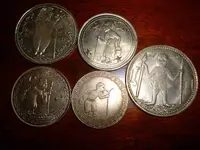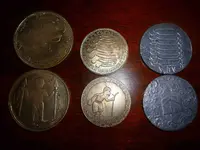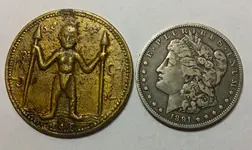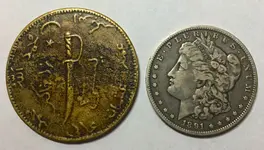Funky item!
Kelantan had its own currency until Siam (now Thailand) ceded control to the British in 1909, who established an exchange bank as the Mercantile Bank of India in 1912 and then by the 1920s determined the Straits Dollar as the only currency.
The coinage system prior to that is poorly documented, but it was based on the ‘Keping’, subdivided into 10 ‘pitis’. All of the generally circulating coins were made from tin, with the pitis being holed to allow them to be strung. The two higher value coins - 1 keping and 10 kepings - were not holed but the latter was only issued in 1903/4 and then withdrawn because of large-scale counterfeiting. In earlier times there had also been several types of small, thin gold coins minted for use in Kelantan but generally used in trade, not as circulating coinage. None of the coins had this ‘man with two spears design’ and there’s no mention of it in Linehan’s paper: “Coins of Kelantan”.
The consensus is that these were talismans of a “keep me safe / make me well / bring me luck / make me rich” nature, with religious undertones. There are a number of different designs and some of them have been tentatively attributed to particular pieces of religious folklore and fable, but no-one seems to know for certain what the guy with two spears is all about.
Along with replicas of the old tin Pitis and Kepings, they’re still making them today. I read on a travel blog that someone had purchased a whole bunch of what he thought were old coins for 5 Ringitt each (about $1.20) at a market in Kota Bharu, Kelantan. The vendor freely told him they were modern replicas, made in Terengganu for sale as souvenir collectibles. These were some of the purchases (all modern-made copies, and only the very last item is a coin copy):










